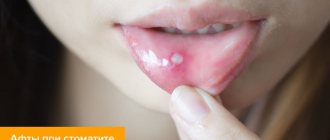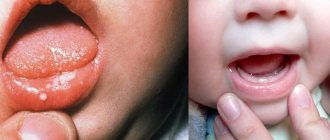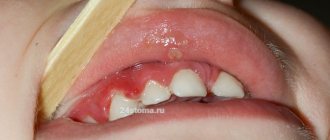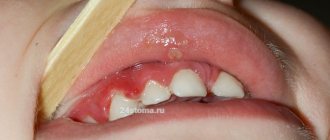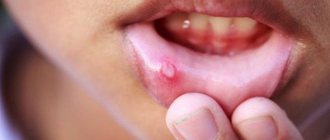March 31, 2020
Aphthous stomatitis is one of the most common inflammatory diseases of the oral cavity.
Aphthous stomatitis is one of the most common inflammatory diseases of the oral cavity. In this article we will tell you what additional examinations should be performed for recurrent stomatitis and how to treat this disease.
Stomatitis affects from 10 to 40% of the world's population. The diagnosis occurs with equal frequency in people in adulthood and childhood. Clinically, stomatitis manifests itself in the form of painful ulcers on the oral mucosa. Such formations are called aphthae. These pathological lesions are round, bright yellow formations with a bright red inflammatory rim in a circle. They can be located anywhere in the mouth, even on the tongue or gum. Sometimes there are multiple rashes.
The most common causes of stomatitis include viral or bacterial infections. Bacterial stomatitis is usually the result of dental problems and poor oral hygiene (for example, not brushing your teeth thoroughly enough). Sometimes aphthous stomatitis appears at the site of injury, burn or abrasion of the mucous membrane. Canker sores may also appear as a result of taking systemic antibacterial drugs.
Causes
The pathology is caused by numerous infectious agents, as well as oral injuries and allergic reactions. The reason for its development may be a lack of certain vitamins and microelements.
The following types are distinguished:
- viral (herpetic - present in 80% of all cases, the rest are represented by measles, chickenpox, influenza, rubella, mononucleosis, adenovirus, enterovirus, papillomavirus viruses);
- fungal – candidiasis is detected in the vast majority of cases in infants; in older children it occurs due to immunodeficiency, diabetes, or taking antibiotics;
- bacterial - most often it is caused by various types of staphylococci and streptococci; in rare cases, stomatitis is caused by pathogens of tuberculosis, syphilis, diphtheria, gonorrhea;
- allergic – often the pathology develops as a reaction to various products, components of toothpaste, chewing gum;
- autoimmune – in the occurrence of aphthous lesions, one of the leading causes is considered to be the presence of autoimmune problems;
- traumatic - in children, the oral mucosa is less stable than in adults; it is easily damaged under the influence of chemical and physical agents, or mechanical trauma.
The factor that caused this pathology determines the treatment tactics and what drugs will be prescribed.
There are factors that contribute to the development of the disease.
These include:
- diseases of the gastrointestinal tract (duodenitis, gastritis, intestinal dysbiosis, colitis, enteritis);
- blood diseases;
- pathologies of the nervous and endocrine systems;
- helminthiases;
- prematurity;
- insufficient oral hygiene;
- weak local immunity;
- lack of microelements, vitamins (B vitamins, selenium, zinc).
All these numerous factors cause and contribute to the development of stomatitis. In this regard, there is a significant difference in the treatment of different types of disease.
How to treat ulcerative stomatitis with diet?
Diet alone will not be enough to completely cure the disease, but it is mandatory to speed up the recovery process. With such a diagnosis, it is very important to devote time to proper nutrition.
For stomatitis, the following products are recommended: vegetables, fruits, viscous porridges, greens, milk and dairy products, cheese, soups, herbal infusions, green tea, steamed meat without salt, low-fat fish, natural vegetable juices.
Patients with this disease are not recommended to eat: sour fruits and vegetables, citrus fruits, pickled and peppered foods. Also not recommended are foods that provoke allergies, too sweet foods, dry foods and those foods that can cause mechanical damage to the mucous membrane (nuts, crackers, dried fruits, etc.).
Kinds
Varieties are distinguished according to the depth of damage to the mucous membrane and the reasons that caused the development of the pathology.
According to the depth of the lesion there are:
- aphthous;
- catarrhal;
- necrotic;
- ulcerative
Treatment varies depending on the stage. For the catarrhal variety, local treatment at home is predominantly prescribed. With the most severe necrotic, the child is hospitalized in a hospital.
Clinical manifestations of different types of disease
Signs of stomatitis in children vary significantly. This depends on the nature of the agent causing the disease.
Signs of this pathology:
- Viral - this type of pathology is characterized by the appearance of bubbles with a clear liquid that quickly open. Then erosive areas of round shape and small size are formed. They are covered with a grayish coating. In severe cases, the lesion has a draining character. The mucous membrane of the oral cavity and nasopharynx is bright red. There is pronounced pain. Similar skin rashes are also noted. The child shows signs of general intoxication and elevated body temperature. Signs of enlarged lymph nodes and conjunctivitis are detected. Possible loose stools and vomiting. Mucosal defects are epithelialized without scarring.
- Fungal - most of this species is candidal. It often develops in infants. It can also appear in children wearing braces. In other cases, its occurrence indicates immunodeficiency or other severe somatic pathologies. On the surface of the mucous membrane, areas covered with white plaque appear, then its area increases. A dense white layer covers the entire oral cavity; it has a curd-like consistency. In severe forms, it becomes gray and sometimes separates, exposing the bleeding surface. With the atrophic variety of the disease, only redness and dryness of the mucous membrane are detected. Plaque appears rarely, only in folds.
- Bacterial - the most common type of infection is the impetiginous type. It is characterized by confluent superficial erosive lesions and a purple color of the mucous membranes. Yellowish crusts form that stick the lips together. Salivation increased. There is an unpleasant odor from the mouth. Body temperature rises.
- Autozny - this variety is more common in children under 7 years of age. It is assumed that it is of an infectious-allergic or autoimmune nature. With it, aphthae appear on the mucous membrane - these are painful ulcers of a necrotic nature. They are round in shape, covered with fibrin, surrounded by a reddish granulation rim. The child's temperature rises, he is bothered by pain in his mouth, and refuses to eat. This option has a chronic course. Typically, exacerbations occur once or twice a year. Outside of exacerbation, aphthae heal.
Symptoms in children are quite varied. They depend on the form of the disease and the pathogen that caused it.
Physiotherapy after coronavirus
Table 3. Popular physiotherapeutic procedures
| № | Name | Action |
| 1. | SMT therapy | Sinusoidal modulated currents eliminate bronchospasms and improve drainage. |
| 2. | Laser therapy | Improves blood circulation, has a resolving and anti-inflammatory effect. |
| 3. | Polychromatic polarized light | Accelerates the resorption of infiltrate, improves bronchial patency. |
| 4. | Magnetotherapy | Eliminates inflammation, swelling, pain. |
| 5. | Ultrasound therapy | Removes phlegm, prevents the development of fibrosis. |
Diagnostics
If a mucosal lesion occurs in the mouth, the patient is examined by a dentist, infectious disease specialist or pediatrician. To identify the cause of the disease, measures are taken to identify the causative agent of the disease.
The following diagnostic methods are used:
- linked immunosorbent assay;
- cytopolymerase reaction;
- tank sowing discharge from ulcers, pieces of mucous membrane and plaque;
- cytological, immunological research methods.
If candidal stomatitis is suspected, an endocrinologist is consulted and tests are performed to detect diabetes mellitus.
In chronic forms of the disease, the following is carried out:
- tests for worm eggs;
- Ultrasound of the abdominal area;
- immunogram;
- stool examination for dysbacteriosis.
Consultations with a gastroenterologist and immunologist are carried out.
Fibrosis – as a consequence for the lungs after COVID-19
Signs of pulmonary fibrosis on CT (computed tomography) indicate that part of the lung tissue is replaced by scar tissue. Fibrosis does not develop in a few days. This usually takes up to 6 months. Fortunately, fatal pulmonary fibrosis leading to severe respiratory failure is not common, and for most people who survive coronavirus infection, the remaining changes in the lungs will not affect their health. In most cases, a control study shows a clear positive trend. Signs of fibrosis decrease or disappear. Normal lung tissue is restored.
Therefore, it is so important to consult a doctor in time and begin proper treatment for COVID-19, which will help avoid serious complications and reduce the recovery time after lung damage from SARS-CoV-2.
Once fibrosis has truly formed, it is irreversible. In this case, doctors try to create optimal conditions for the functioning of the remaining lung tissue. This can often be done, since the compensatory capabilities of the respiratory system are great. But simple methods are not enough for this. It is necessary to involve serious therapy, including medications and respiratory support.
Treatment of various types
After identifying the cause of the disease and identification, stomatitis in children is immediately treated. Self-medication is unacceptable; only a doctor can recommend medications and determine the duration of their course. General and local methods are used for treatment. For a sick child, in addition to treating the disease, dietary nutrition is important. Food should be pureed and not irritate the mucous membranes. The food your baby eats should be at room temperature. Before meals, regardless of the type, painkillers are used (Kalgel, Kamistad).
Treatment of viral stomatitis
For the treatment of viral stomatitis, primarily hermetic, antiviral drugs are used (Oxolinic ointment, Zovirax, Acyclovir, Valtarex, Tebrofen ointment). They lubricate the mucous membranes in the baby’s mouth up to four times a day.
In addition to antivirals, other medications are used:
- antiseptics (Miramistin, Vinilin, Sodium Tetraborate) - they are used to treat the oral mucosa, rinsing is carried out up to four times a day;
- complex drug Viferon - contains interferon, antiseptics, vitamins E and C, it is applied to the affected mucosa for ten days;
- immunomodulators (Sodium Nucleinate, Immunal, Amiksin) – strengthen general and local immunity, used for a course of up to two months;
- anti-inflammatory and antipyretic drugs (Nurofen, Paracetomol) are used to reduce fever and inflammation;
- antihistamines improve the general condition of the baby (Tavegil, Suprastin).
You can use herbal preparations (Stomatidin, Karotolin, Rotokan) that have anti-inflammatory and healing properties
Treatment of candidal stomatitis
Antifungal drugs play a leading role in treatment.
These include:
- Pimafucin;
- Fluconazole;
- Clotrimazole;
- Candide in solution.
The oral cavity is treated several times a day using a moistened cotton pad.
The following products are also used for home treatment:
- soda solution;
- boric acid solution;
- decoction of string;
- sage;
- daisies.
Rinses with these liquids are used. Then use a cotton swab to remove the fungal plaque.
Treatment of aphthous stomatitis
Along with diet, medications and external agents are used for treatment. The disease is severe, so treatment is prescribed only by a doctor.
The following medications are used:
- antihistamines (Suprastin, Citrine, Zodak) - they relieve allergic manifestations by blocking inflammatory mediators;
- antiviral drugs (Tamiflu, Arbidol, Remantadine) - help fight viruses that cause the formation of canker sores;
- vitamin complexes (Pikovit, Alphabet) to strengthen the immune system;
- gels for pain relief of ulcers (Instillagel, Kalgel, Kamistad) are used up to four times a day, they are lubricated with the oral mucosa in the affected areas;
- for rinsing, use herbal decoctions (peppermint, calendula, sage) - they are used every four hours;
- To accelerate the epithelization of ulcers, sea buckthorn oil is used, it is used up to three times a day;
- Aloe juice effectively heals aphthae in the oral cavity; to do this, take pieces of the leaf, cut in half and wipe the inside of the mucous membrane three times a day.
If treatment does not improve, the doctor prescribes antibiotics and glucocorticoid drugs.
Treatment of bacterial stomatitis
Medicines for this stomatitis are prescribed by a doctor. Antibiotics are used after studying the sensitivity of bacteria to various antibiotics, and the most effective one is selected. In addition to them, immunostimulants, antiseptics, and anti-inflammatory drugs are used.
These include:
- antiseptic solutions and sprays (Chlorhexidine, Tantum Verde, Hexaral) - the oral cavity is treated with these products after each meal, but no more than six times a day;
- Decoctions of herbs (cinquefoil, chamomile, St. John's wort) are also useful - you should rinse your mouth with them in between antiseptics;
- treatment of affected surfaces with hydrogen peroxide has a positive effect;
- Metrogyl Denta - gel is an antibiotic, used for treatment until the sensitivity of bacteria to antibiotics is determined;
- Lidochlor, Vinilin, Eucalyptus M are used for pain relief and restoration of the mucous membrane.
It is also advisable to use immunostimulating drugs to speed up recovery after suppression of the bacterial flora.
Treatment of traumatic stomatitis
Therapy for this lesion should begin immediately and be comprehensive.
The following drugs are used for treatment:
- antiseptics (hydrogen peroxide, Furacillin solution, calendula tincture) - they treat the affected areas;
- To prevent replenishment, anti-inflammatory antimicrobial drugs (Lugol, Hexalize, Miramistin, Cholisal) are used; surfaces can be treated up to six times a day;
- painkillers (Kamistad, Lidocaine Asept) - applied to the surface twice a day;
- drugs that promote healing (Rotocan, Chlorophyllipt) - they are lubricated with the affected mucous membrane up to three times a day.
When there is permanent mechanical injury, it must be eliminated. Chipped teeth are treated and orthodontic appliances are adjusted.
Contraindications
When used externally, hydrogen peroxide is a completely safe drug, the use of which is permitted, including during pregnancy. It is believed that the only contraindication to use is individual intolerance, which is rare. However, doctors also recommend caution with the following diseases:
- renal and liver failure;
- hyperthyroidism;
- Dühring's dermatitis.
The solution should not be swallowed.
In reviews, patients call hydrogen peroxide a universal remedy that can disinfect wounds and stop inflammatory processes. This liquid eliminates the symptoms of stomatitis, but does not affect its causes, so it is impossible to limit therapy to peroxide alone. It must be comprehensive, prescribed by a doctor after diagnosis has determined the main cause of the disease.
Sources:
- Therapeutic dentistry. Ed. E.V. Borovsky. Moscow, 2004.
- Kildiyarova R., Kolesnikova M. Handbook of pediatricians. Moscow, 2015.
Prevention
The occurrence of stomatitis is much easier to prevent. To do this, just follow simple rules.
Recommended:
- clean your mouth twice a day under parental supervision;
- regularly take your child to the dentist for preventive examinations;
- promptly treat dental caries;
- avoid injury to the oral mucosa;
- timely treat all somatic diseases in the baby;
- disinfect dishes and toys;
- prohibit the baby from putting dirty objects and hands in his mouth.
Stomatitis has different origins and is caused by different pathogens. Therefore, only a doctor should treat these diseases. Self-medication is unacceptable, since a thorough diagnosis is necessary before treatment. Identification of the causative agent of the disease is a condition for successful treatment.
Properties of peroxide
The product is an odorless and colorless liquid with the chemical formula H2O2. It contains twice as many oxygen atoms as water and is a strong oxidizing agent. This explains the disinfecting ability: oxygen, foaming, cleans even the deepest parts of the wound. Main properties of the drug:
- disinfection;
- hemostatic effect;
- antiseptic effect;
- removal of contaminants from wound surfaces.
The drug is widely used in medicine for treating wounds and treating ENT diseases. Another area of application is cosmetology: the product can whiten teeth at home; it is an integral part of cosmetic face masks.
Peroxide contains twice as many oxygen atoms as water and is a strong oxidizing agent.
For stomatitis, the drug is used not as an independent remedy, but as part of complex therapy, to cleanse the oral cavity before applying medicinal gels.


